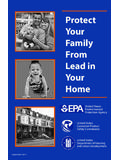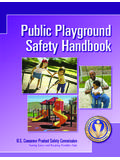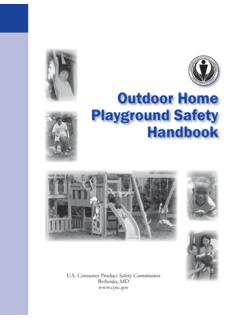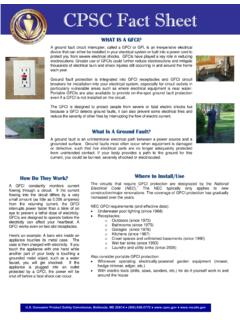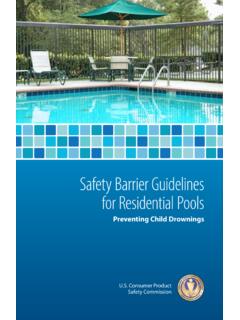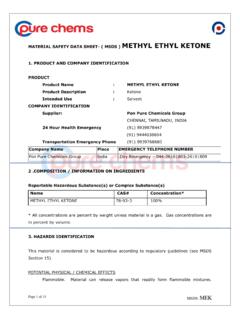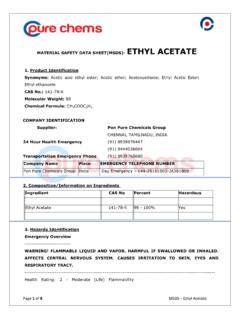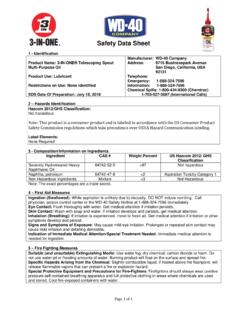Transcription of Overview of U.S. Requirements for Textiles/Apparel
1 This presentation was prepared by CPSC staff, has not been reviewed or approved by, and may not reflect the views of the Commission. 1 Overview of Requirements for Textiles/Apparel Allyson Tenney Consumer Product Safety Commission September 2016 Overview 2 flammable Fabrics Act Requirements for Apparel and Clothing in the United States Flammability Requirements for Apparel Requirements for Children s Apparel and Sleepwear Requirements for other Regulated Textile Products in the United States flammable Fabrics Act (FFA) Regulated Products: Clothing Textiles, 16 CFR part 1610 Vinyl Plastic Film, 16 CFR part 1611 Children s Sleepwear, 16 CFR parts 1615/1616 Carpets and Rugs, 16 CFR parts 1630/1631 Mattresses and Mattress Pads, 16 CFR part 1632 Mattress Sets, 16 CFR part 1633 3 Standard for the Flammability of Clothing Textiles (16 CFR part 1610) 4 16 CFR part 1610 commonly known as the General Wearing Apparel Standard Enacted in the 1950s Keeps the most dangerously flammable textile products and garments out of the marketplace Part 1610 - Scope 5 Wearing Apparel: The Standard applies to all textiles used for adult and children s wearing apparel.
2 Does not apply to: Certain hats, gloves, footwear, interlining fabrics Children s sleepwear must meet a more stringent standard Part 1610 - Specific Exemptions 6 Fabrics that meet a specific exemption do not require testing. Determined by fabric type and specifications Plain-surface textile fabric or raised-fiber surface Fabric weight Fiber content Plain-surface fabrics g/m2 ( oz/yd2), regardless of fiber content Plain- and raised-fiber surface fabrics made of certain fibers: Acrylic, modacrylic, nylon, olefin, polyester, wool, or any combination of these fibers, regardless of weight Part 1610-Classifications 7 The Standard specifies testing procedures and determines the relative flammability of textiles used in apparel using three classes of flammability. The burn time of several specimens is averaged and a Class (Class 1, 2, or 3) designation is made based on: Average burn time (speed of burning) Surface characteristics Class 3 textiles are considered dangerously flammable and are not suitable for use in clothing, due to their rapid and intense burning.
3 Part 1610 - Testing 8 2 x 6 inch specimen 45-degree angle 16 mm flame 1 second ignition Surface ignition Burn time is recorded Prescribed sample preparation Refurbishing required Common Noncomplying Fabrics 9 Sheer 100% rayon Sheer 100% silk 100% rayon chenille Certain rayon/nylon chenille Certain polyester/cotton and 100% cotton fleece 100% cotton terry cloth Standard for the Flammability of Vinyl Plastic Film (16 CFR part 1611) 10 16 CFR part 1611- Part of original FFA commercial standard from the 1950s, codified in 1975 Applies to non-rigid, unsupported vinyl plastic film, including transparent, translucent, and opaque material used in wearing apparel subject to the FFA Disposable diapers Raincoats Summary of Requirements for Clothing 11 Wearing apparel is tested to either part 1610 or part 1611 (Flammability) Examples include daywear clothing (adults and children), outerwear, diapers, socks, infant garments Children s sleepwear is subject to more stringent standards.
4 Standards for the Flammability of Children s Sleepwear (16 CFR parts 1615/1616) 12 The children s sleepwear standards (16 CFR Parts 1615 and 1616) were developed in the early 1970s to address the ignition of children s sleepwear, such as nightgowns, pajamas, and robes. The standards are designed to protect children from small open-flame sources, such as matches/lighters, candles, fireplace embers, stoves, and space heaters. The standards are not intended to protect children from large fires or fires started by flammable liquids, such as gasoline. Parts 1615 & 1616 - Scope 13 Children s sleepwear means any product of wearing apparel intended to be worn primarily for sleeping or activities related to sleep in size 0 through size 14. Nightgowns, pajamas, robes, or similar or related items, such as loungewear, are included.
5 Several factors determine if a garment is sleepwear: Suitability for sleeping, likelihood of garment to be used for sleeping Garment and fabric features Marketing, merchandising/display, intended use Parts 1615 & 1616 - Flammability 14 Children s sleepwear must pass specified flammability Requirements . All fabrics and garments must be flame resistant and self-extinguish (not continue to burn) when removed from a small, open-flame ignition source. Parts 1615 & 1616 - Summary 15 Fabric, seams, trims, and garments must pass certain flammability tests Te s t s conducted in original state and after 50 laundering cycles (if the sample passes the original state test) Tested samples are required to be retained Standards include production testing and recordkeeping Requirements Parts 1615 & 1616 Testing 16 x 10 inch specimen Vertical position 38 mm flame 3 second ignition Bottom edge ignition Char length is measured Prescribed sample preparation Required laundering Parts 1615 & 1616 Exemptions 17 Category Exceptions Diapers and Underwear (exempt) Must comply with 16 CFR Part 1610 Infant garments (exempt) Sizes 9 months or younger One-piece garment does not exceed cm ( ) in length Two-piece garment has no piece exceeding 40 cm ( )
6 In length Must comply with 16 CFR Part 1610 Tight-Fitting Sleepwear 18 Tight-Fitting Sleepwear (exception) Tight-fitting garments (defined by the Standards) are exempt from testing to the sleepwear Requirements . Must meet specific maximum dimensions Must comply with 16 CFR part 1610 Must meet tight-fitting label and hang tag Requirements Labeling Requirements for Tight-Fitting Sleepwear 19 WEAR SNUG-FITTING NOT FLAME RESISTANT Neck label must be at least 5 point sans serif font, all capital letters, set apart from other text by line border, on a contrasting background and not covered by other labels. Hangtag must be yellow (specified color code) and measure x with a 1 x text box Arial/Helvetica black 18 point font For child s safety, garment should fit snugly. This garment is not flame resistant.
7 Loose-fitting garment is more likely to catch fire. CPSIA Requirements for Children s Apparel and Sleepwear 20 Comply with all applicable children s product safety rules Flammability Lead content and lead surface coating limits must be met Child care articles (for children 3 and under) are subject to phthalate Requirements Issue a Children s Product Certificate (CPC) CPC shows conformance to applicable Requirements ( , flammability, lead, phthalates) based on third party testing Use accredited third party CPSC-accepted laboratory Have permanent tracking information affixed to the product and its packaging, when practicable Lead - Clothing and Textiles 21 Lead content and surface coating limits must be met for certain accessible components of textile products, clothing, and clothing accessories. Buttons, snaps, grommets and zippers must meet total lead content Requirements .
8 Painted buttons and snaps, painted zippers, heat transfers, and screen prints are subject to the lead in surface coating ban. Inaccessible lead component parts are exempt. Component part testing permitted Lead Determinations - Textiles 16 CFR Section : Certain materials will not exceed lead limits Includes dyed or undyed textiles and nonmetallic thread Currently do not require third party testing 22 Screen Printing 23 Screen printing generally considered to be a surface coating Subject to the lead in paint and surface coating limits (90 ppm) Compliance and Testing Test finished product at accredited CPSC-accepted laboratory Component part testing Obtain testing results or CPC from print ink, paint, pigment supplier Screen printing on children s sleepwear for children under 3 (child care article) also subject to phthalate Requirements .
9 Phthalates - Child Care Articles 24 Phthalates are chemical plasticizers that are often used in the production of many types of plastics, certain inks, paints, and other products. Applies to plasticized component parts in toys and child care articles (facilitates eating, sleeping) Accessible component parts Children s bibs Children s sleepwear for children under 3 Mattresses for children under three Tracking Information 25 Small Parts on Clothing 26 CPSC regulations for small parts used on products for children under 3 Regulation prevents deaths and injuries to children from choking Children s Clothing and Accessories Fabrics and buttons are exempted from small parts regulations and testing Requirements . Buttons and other fasteners are not required to be tested for small parts conformity but should be secure.
10 If buttons start falling off due to poor construction, they may pose a substantial product hazard; this should be reported to the CPSC as a possible hazard. Drawstrings 27 Young children can be seriously injured or subject to fatal entanglement if the drawstrings of the upper outerwear they are wearing catches or snags. In 2012, the Commission determined that drawstrings on children s upper outerwear present a substantial product hazard and issued a rule under 15(j) of the Consumer Product Safety Act (CPSA). Children s upper outerwear sold in the United States should comply with the voluntary safety standard, ASTM F-1816 Standard Consumer Safety Specification for Drawstrings on Children s Upper Outerwear. Drawstrings Definitions 28 CPSC defines upper outerwear as clothing such as jackets, ski vests, anoraks, and sweatshirts that generally are intended to be worn on the exterior of other garments, including lightweight outerwear that is appropriate for use in warmer climates.
